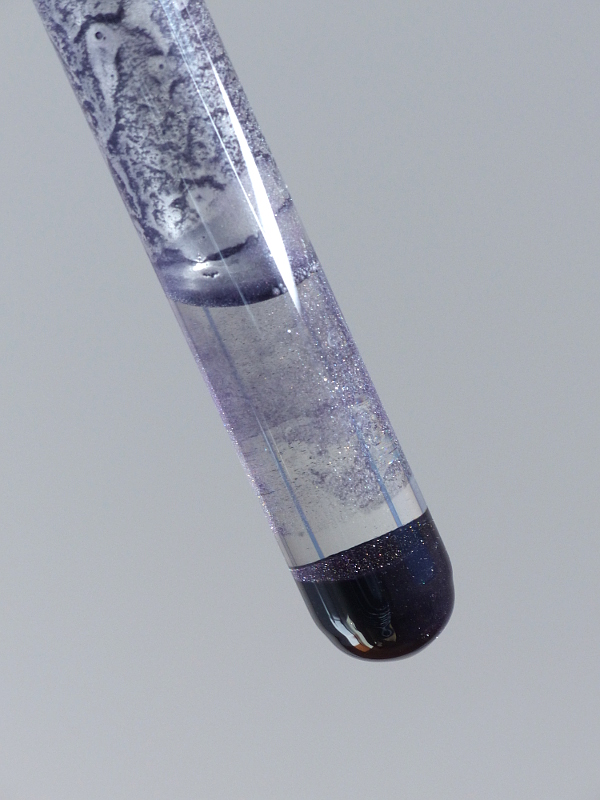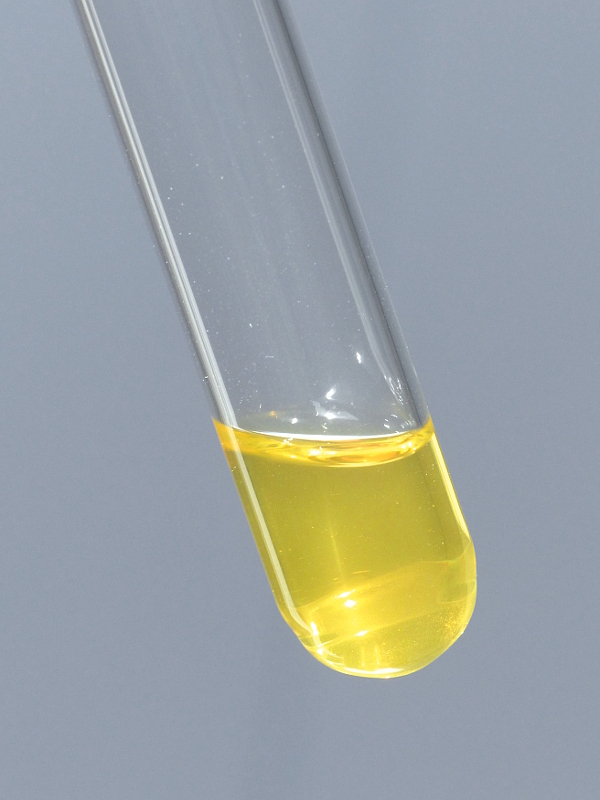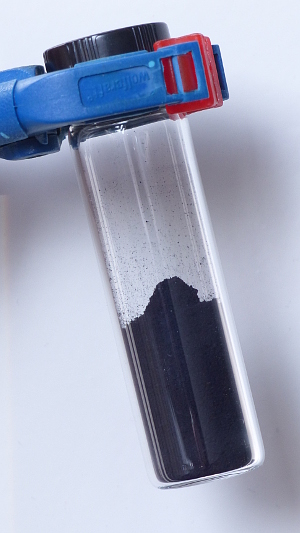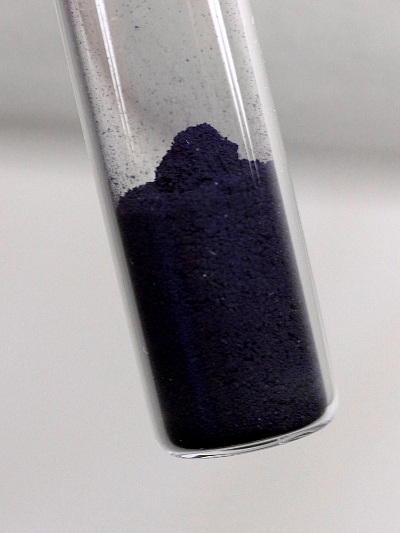


Preparation of a mixed-oxidation-state antimony compound
Antimony forms chloro complexes quite easily in concentrated solutions of hydrochloric acid. Both antimony(III) and antimony(V) form such complexes. These complexes can be written as SbCl63– and SbCl6–. Both of these complexes only can exist at very low pH. In neutral water, these ions quickly decompose, giving insoluble oxides and basic chlorides of antimony, free chloride ions and HCl. The SbCl63– anion is colorless and the SbCl6– anion is nearly colorless (very pale yellow/green).
In very concentrated solutions of HCl, however, there is interaction between the two anions. Solutions, having both anions have a deep golden yellow color. When cesium ions are added in the mix, then a really remarkable insoluble compound is formed with a very dark blue/indigo color, nearly black. In this experiment, a few grams of the compound are formed, isolated and dried. Some properties of the dark compound are demonstrated as well.
![]()
![]() Required chemicals:
Required chemicals:
- antimony sesquioxide, Sb2O3
- concentrated hydrochloric acid
- cesium chloride
- hydrogen peroxide (30% by weight)
![]() Required equipment:
Required equipment:
- test tubes
-
little beakers or erlenmeyers
![]() Safety:
Safety:
- Concentrated hydrochloric acid is corrosive. Avoid contact with skin. If by accident some of the acid comes in contact with skin, then quickly rinse the skin with plenty of water.
- During the experiment, dense fumes of HCl are formed, avoid inhaling these fumes. Work outside, or in a fume hood.
- There is some uncertainty about the
toxicity of antimony sesquioxide. Some sources state it is a suspected
carcinogen when inhaled as dust, otherwise, its toxicity is quite low.
To be sure, avoid inhalation of fine dust of the oxide and be sure not
to inhale fine droplets of an aerosol, containing dissolved
antimony-species.
- Hydrogen peroxide at high concentrations is very corrosive to skin. It gives white spots on the skin, which can be strongly itching. Avoid contact with the skin!
![]() Disposal:
Disposal:
- Solutions, containing antimony can best be kept aside and be brought to a municipal waste processing facility as chemical waste.
![]()
Preparation of separate solutions of antimony(III) and antimony(V)
Two
separate solutions of antimony must be prepared, both in concentrated
hydrochloric acid, and both of approximately equal molarity in
antimony. The following procedure works fine:
![]() Take appr. 15 ml of concentrated hydrochloric acid (35% HCl by weight) and put this in a test tube.
Take appr. 15 ml of concentrated hydrochloric acid (35% HCl by weight) and put this in a test tube.
![]() Take 500 mg of Sb2O3 and dissolve this in the concentrated HCl. It is important to weigh the amount of Sb2O3 accurately. The amount of HCl is not critical.
Take 500 mg of Sb2O3 and dissolve this in the concentrated HCl. It is important to weigh the amount of Sb2O3 accurately. The amount of HCl is not critical.
![]() Dissolve another portion of accurately weighed 500 mg of Sb2O3 in another portion of appr. 15 ml of concentrated hydrochloric acid (35% HCl by weight) and put this in a test tube as well.
Dissolve another portion of accurately weighed 500 mg of Sb2O3 in another portion of appr. 15 ml of concentrated hydrochloric acid (35% HCl by weight) and put this in a test tube as well.
If pottery grade Sb2O3
is used, then the
solution probably remains turbid. If this is the case,
allow to settle for a day and then using a pipette take the clear
solution from the white solid material at the bottom. After this step,
there should be two portions of appr. 15 ml of solution of Sb2O3 in conc. HCl. Some slight opalescence is acceptable, milk-white turbidity is not OK.
![]() Pour one of the portions in a small erlenmeyer and dropwise add appr. 0.5 ml of 30% H2O2,
while swirling. This makes the solution green/yellow and bubbles of a
mix of oxygen and chlorine are formed almost immediately. This is a
large excess of hydrogen peroxide, assuring that all antimony is
oxidized to the +5 oxidation state. Boil off the solution with the
hydrogen peroxide. This drives off chlorine and destroys the excess
hydrogen peroxide. Keep on simmering for a minute or so. After this,
all chlorine is driven off and all hydrogen peroxide is destroyed. This
step definitely must be done outside or in a fume hood. The
concentrated HCl gives off a lot of fumes and these are very corrosive
and certainly should not be inhaled! Because of the bubbling and
boiling, fine droplets of solution, containing antimony, can be
released into the air. This is another reason for working outside or in
a fume hood. The resulting solution is pale yellow/green. This color is
not due to the presence of chlorine, it is the color of the complex ion
SbCl6–.
Pour one of the portions in a small erlenmeyer and dropwise add appr. 0.5 ml of 30% H2O2,
while swirling. This makes the solution green/yellow and bubbles of a
mix of oxygen and chlorine are formed almost immediately. This is a
large excess of hydrogen peroxide, assuring that all antimony is
oxidized to the +5 oxidation state. Boil off the solution with the
hydrogen peroxide. This drives off chlorine and destroys the excess
hydrogen peroxide. Keep on simmering for a minute or so. After this,
all chlorine is driven off and all hydrogen peroxide is destroyed. This
step definitely must be done outside or in a fume hood. The
concentrated HCl gives off a lot of fumes and these are very corrosive
and certainly should not be inhaled! Because of the bubbling and
boiling, fine droplets of solution, containing antimony, can be
released into the air. This is another reason for working outside or in
a fume hood. The resulting solution is pale yellow/green. This color is
not due to the presence of chlorine, it is the color of the complex ion
SbCl6–.
After the above steps, there is a colorless solution, containing antimony(III) and a very pale yellow/green solution, containing antimony(V). Both solutions can be slightly opalescent.
Preparation of mixed-oxidation-state antimony(III/V) compound
![]() Both solutions, described above, can be mixed. This can best be done,
while the solution with antimony(V) is still hot. Carefully pour the
hot solution of antimony(V) into the solution of antimony(III) and then
mix the solutions. Quickly, the resulting mix becomes golden yellow.
The color of the solution is quite intense. The picture below shows a
testtube, holding a few ml of this golden yellow solution.
Both solutions, described above, can be mixed. This can best be done,
while the solution with antimony(V) is still hot. Carefully pour the
hot solution of antimony(V) into the solution of antimony(III) and then
mix the solutions. Quickly, the resulting mix becomes golden yellow.
The color of the solution is quite intense. The picture below shows a
testtube, holding a few ml of this golden yellow solution.

The picture was made with the
liquid in sunlight, with a gray background. The picture shows a slight
opalescence of the solution.
![]() In a separate small beaker, dissolve at least 2.5 grams of cesium
chloride in 20 ml of conc. HCl. This is a slight excess amount of
cesium, assuming formation of the double salt of SbCl63– and SbCl6–.
In a separate small beaker, dissolve at least 2.5 grams of cesium
chloride in 20 ml of conc. HCl. This is a slight excess amount of
cesium, assuming formation of the double salt of SbCl63– and SbCl6–.
![]() Slowly pour the golden/yellow solution of antimony(III/V) into the solution of CsCl, not the other way around. Do this while swirling or stirring constantly. This assures that an excess of cesium ions is present at all times.
Slowly pour the golden/yellow solution of antimony(III/V) into the solution of CsCl, not the other way around. Do this while swirling or stirring constantly. This assures that an excess of cesium ions is present at all times.
When the above procedure is followed, then a lot of very dark blue/purple solid material is formed. The material is not slimy or flocculent, it is a fine crystalline powder, which easily settles at the bottom. Nice glittering crystals can be observed in sunlight. The picture below shows some of the solid material, made in the same reaction on a smaller scale in a test tube.

The picture shows that the precipitate is crystalline and that the liquid above it is perfectly colorless.
![]() Allow the solid material to settle for a few hours and then decant most
of the clear liquid above the dark solid. The clear liquid is
colorless, no faint purple or blue color can be observed. Keep the
liquid for a further experiment.
Allow the solid material to settle for a few hours and then decant most
of the clear liquid above the dark solid. The clear liquid is
colorless, no faint purple or blue color can be observed. Keep the
liquid for a further experiment.
![]() The still wet solid carefully must be put on a good filter (paper
tissue or toilet paper is not suitable, due to the highly concentrated
HCl in the liquid). Put the filter on a pile of paper tissue and then
drip the dark solid/liquid mix onto the filter paper. The liquid
quickly is absorbed by the underlying paper tissue. Replace the pile of
paper tissue if necessary. Finally, take the filter paper with the
already fairly dry solid material, fold it and then press it between
several layers of paper tissue to press out all remaining liquid.
Repeat this a few times until no visible amount of liquid is absorbed
by the paper tissue anymore.
The still wet solid carefully must be put on a good filter (paper
tissue or toilet paper is not suitable, due to the highly concentrated
HCl in the liquid). Put the filter on a pile of paper tissue and then
drip the dark solid/liquid mix onto the filter paper. The liquid
quickly is absorbed by the underlying paper tissue. Replace the pile of
paper tissue if necessary. Finally, take the filter paper with the
already fairly dry solid material, fold it and then press it between
several layers of paper tissue to press out all remaining liquid.
Repeat this a few times until no visible amount of liquid is absorbed
by the paper tissue anymore.
![]() Finally scrape off the dark solid from the filter paper and put it in a
petri dish or watch glass and allow to dry in a warm and dry place.
Initially, the blue solid will have a pungent odour of HCl, but after a
few hours that smell will have disappeared. Crunch the solid somewhat
after a few hours and allow the drying process to continue. After one
day and two times of crunching the solid particles, a nice dry very
dark blue/purple crystalline powder is obtained.
Finally scrape off the dark solid from the filter paper and put it in a
petri dish or watch glass and allow to dry in a warm and dry place.
Initially, the blue solid will have a pungent odour of HCl, but after a
few hours that smell will have disappeared. Crunch the solid somewhat
after a few hours and allow the drying process to continue. After one
day and two times of crunching the solid particles, a nice dry very
dark blue/purple crystalline powder is obtained.
Keep the filter paper with remains
of the black solid. Allow it to dry for a day. It can be used for a
nice experiment, which is described below.
Total yield is 3.9 grams, which is
95% of theoretical 100% yield of 4.1 grams). The reaction itself is
nearly quantitative in terms of used antimony. The losses are
mechanical, due to remains adhering to filter paper and beaker. The two
pictures below show the final dried result, a nearly black fine
crystalline powder.


![]()
The colorless liquid above the dark crystalline precipitate
If the colorless liquid is kept
then it can be tested easily for antimony. In this experiment, the
liquid remains perfectly clear when it is diluted with a lot of water.
This means that practically all antimony is incorporated into the dark
crystalline solid. If even just a few tenths of percents of all
antimony would be present in the liquid, then on dilution it would
become turbid.
![]()
Some properties of the dark product
The dark material is totally insoluble in hydrochloric acid. Some of it, added to conc. HCl does not dissolve. It remains present as fine black particles, which quickly settle to the bottom.
The material is very water-sensitive. Even if still wet with acid, when a lot of water is added, it quickly decomposes (hydrolyses), giving a white compound. Below follow two videos, one with the material in the filter paper, still wet with concentrated HCl, the other with the dried material to which some tap water is added.
Video of adding water to the still wet and acidic solid on a filter paper.
Video of adding water to the dried material on a filter paper.
![]()
Discussion of results
![]() When antimony sesquioxide is dissolved in highly concentrated
hydrochloric acid, then a chloro-complex is formed. The reaction can be
described as follows:
When antimony sesquioxide is dissolved in highly concentrated
hydrochloric acid, then a chloro-complex is formed. The reaction can be
described as follows:
Sb2O3 + 6H+ + 12Cl– → 2SbCl63– + 3H2O
On dilution with water, the reverse reaction occurs, or intermediate insoluble products like SbOCl are formed. The SbCl63–-complex only is stable in excess concentrated hydrochloric acid. It is colorless.
![]() The chloro-complex of antimony(III), as described above, easily is oxidized to an antimony(V) complex by hydrogen peroxide:
The chloro-complex of antimony(III), as described above, easily is oxidized to an antimony(V) complex by hydrogen peroxide:
SbCl63– + H2O2 + 2H+ → SbCl6– + 2H2O
This antimony(V) complex also is very easily hydrolysed. On dilution with water, it reacts to form insoluble Sb2O5 and dilute hydrochloric acid. The SbCl6– ion has a very pale green/yellow color.
![]() When both complex ions SbCl63– and SbCl6–
are present in the same solution, then there is some interaction. A
solution, containing both complexes, has an intense golden/yellow
color. Probably some labile larger complex is formedwith charge transfer between the two species.
When both complex ions SbCl63– and SbCl6–
are present in the same solution, then there is some interaction. A
solution, containing both complexes, has an intense golden/yellow
color. Probably some labile larger complex is formedwith charge transfer between the two species.
![]() With cesium ions, a remarkable reaction occurs. Cesium forms highly insoluble salts with both SbCl63– and SbCl6–.
These salts are white. However, when both ions are present at the same
time, then strongly colored species are formed, which contain both
cations:
With cesium ions, a remarkable reaction occurs. Cesium forms highly insoluble salts with both SbCl63– and SbCl6–.
These salts are white. However, when both ions are present at the same
time, then strongly colored species are formed, which contain both
cations:
6Cs+ + SbCl63– + SbCl6– →Cs3SbCl6 · CsSbCl6
Other stoichiometries are possible as well. In practice, all antimony is precipitated if excess cesium ions are present. When the ions SbCl63– and SbCl6– are present in a 1 : 1 ratio, the color of the double salt is strongest. It then is dark blue/purple, nearly black. In literature, other colors are reported for other stoichiometries.
The dark compound is only stable in the solid state, or in the presence of concentrated HCl. If it comes in contact with water, then it quickly hydrolyses, giving a solution of CsCl and an insoluble mix of Sb2O3 and Sb2O5.
See also: Inorganic Chemistry, by C.E. Housecroft and A.G. Sharpe, pp. 410